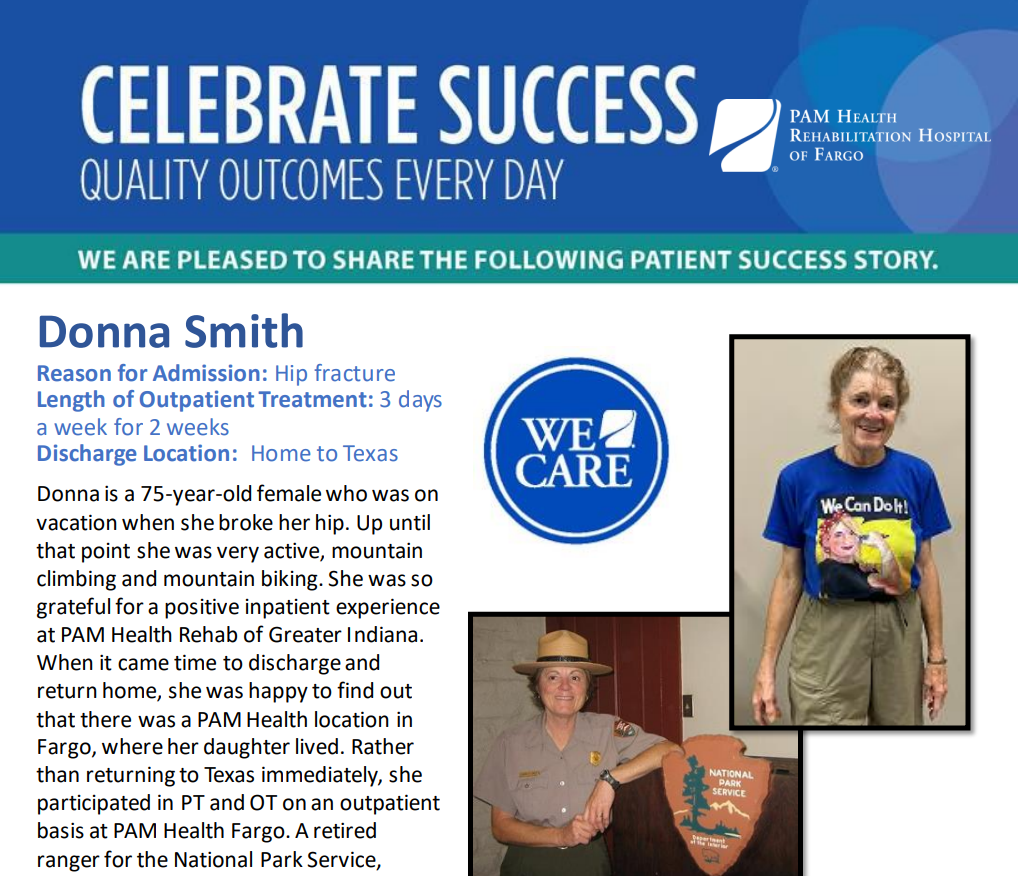
Prevent Risky Falls Before They Happen
It has happened to nearly everyone. One minute you are happily walking along, and the next you are lying on the ground wondering what happened. Falls can happen that quickly and easily. A wet floor, uneven sidewalk, or loose rug can all cause you to trip and fall. Fortunately, most of the time, falls do not result in much more than a bruised ego. But for adults over the age of 65 and others with risk factors, a fall can lead to a serious injury or hospitalization. In fact, falls are the leading cause of fatal and nonfatal injuries in older adults. The American Occupational Therapy Association reports that about 3 million older adults go to the emergency room for medical assistance after a fall.[1] However, the good news is that many falls can be prevented. Taking safety precautions and managing one’s health are two of the keys to staying healthy and active at any age.
Explore Occupational Therapy Offered by PAM Health
The first step in fall prevention is to understand why it is so important.
Falls Can Be Serious Business
- One out of 5 falls causes a serious injury like a broken bone or serious cut
- 300,000 older adults experience a hip fracture annually[2]
- 95% of hip fractures are caused by falling[3]
- Falls are the most common cause of traumatic brain injuries (TBI)[4]
Because medical care for older adults can be more complex due to pre-existing conditions and medications, advanced age, and frailty, even minor falls for members of this age group can cause increased complications and be harder to recover fully from, both mentally and physically, according to an article on AgingCare.com.
Studies have also indicated that after someone has fallen once, their chances of falling again double! So if you or someone you know has taken a nasty spill, be sure to do all that you can to prevent the next one.


Although the cause of a fall can vary, there are obvious risk factors than can contribute to an unsafe environment or elevate a person’s chances of falling. Some of those include[5]:
- Prescription and over-the-counter medications that cause dizziness or affect balance
- Vision problems that make it difficult to see and impact depth perception
- Difficulty walking due to an injury or weakness
- Poor balance
- Foot or leg pain
- Footwear that is old or inappropriate for the conditions
- Tripping hazards – broken or uneven steps, cords, rugs, wet floors or clutter
- Uneven sidewalks or pavement
Preventing Falls
By identifying some of the common contributing factors, you can take steps to manage fall risk factors[6] within your control.
- Keep floors clear of debris and clutter
- Repair uneven surfaces
- Use a walker or cane for additional stability, if needed
- Wear appropriate footwear for weather and walking conditions
- Apply grab bars and no-slip strips in shower and bath
- Install and use stair railings
- Talk to your doctor or pharmacist about your medications
- Consult with your eye doctor about your vision
Another way to reduce your fall risk and enhance your health at any age is to embrace a healthy lifestyle. For instance, tai chi and yoga are low-impact exercises that increase your strength, balance, and flexibility, while also promoting healthy movement. Eating a nutritious diet rich in vitamins, minerals, and protein can help in building muscle and maintaining a healthy weight. Calcium and vitamin D are beneficial for your bones. Staying active and involved will get you out and about, which is beneficial for your mental health as well as your physical conditioning.

After a Fall
If you have recently experienced a fall, physical or occupational therapy may be able to both help you recover and reduce your chances of falling again. At PAM Health, our occupational and physical therapy teams are experts in assisting patients recovering from the aftereffects of a fall. They will complete a thorough assessment to identify the issues within your control and help you minimize your risks of a future accident.
Find a PAM Health Location Near You
Your specific therapy plan will be developed according to your specific condition and goals. However, some common approaches[7] to incorporating therapy to prevent future falls include:
- Building overall muscle and core strength
- Developing better balance
- Evaluating gait and incorporating assistive devices when needed (walker, cane, etc.)
- Recommending appropriate footwear
- Reviewing medications and underlying conditions
They will also talk to you about your home environment and make recommendations to help keep you safe.
Stay Safe!
Although falls are a part of life, they do not have to be. By taking the right steps, you can reduce your risk of a fall and serious injury.
Click here to read about one of our amazing fall recovery success stories!
Citations
[1] (Meydam, 2023)
[2] (Centers for Disease Control and Prevention, 2023)
[3] (Centers for Disease Control and Prevention, 2023)
[4] (Centers for Disease Control and Prevention, 2023)
[5] (National Council on Aging, 2021)
[6] (National Council on Aging, 2021)
[7] (Meydam, 2023)
Bibliography
Centers for Disease Control and Prevention. (2023, May 12). Facts About Falls. Retrieved from CDC.gov: https://www.cdc.gov/falls/facts.html
Meydam, J. (2023, March 4). Occupational Therapy's Role in Fall Prevention. Retrieved from My OT Spot: https://www.myotspot.com/ot-fall-prevention/
National Council on Aging. (2021, July 13). 6 Falls Prevention Steps to Help Your Older Loved Ones. Retrieved from National Council on Aging: https://www.ncoa.org/article/6-falls-prevention-steps-to-help-your-older-loved-ones
